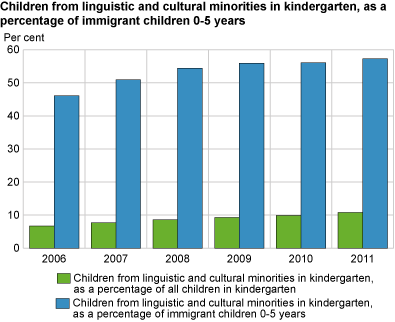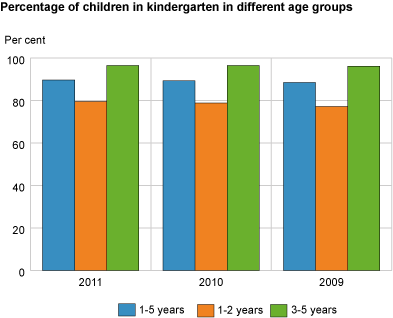Content
Published:
This is an archived release.
Children in kindergartens, 2011
At the end of 2011, nearly 90 per cent of all children aged 1-5 years attended kindergarten. This was almost the same level as in 2010, although the number of children in day care has increased by 5 600 and is now close to 283 000.
The right to a place in kindergarten was introduced by the government on 1 January 2009. Since 2009, the proportion of children aged 3-5 years has been almost unchanged and was 96.5 per cent in 2011. Similarly, the proportion of children aged 1-2 years increased by 2.3 percentage points and was 79.5 per cent at the end of 2011. For children aged 1-5, 89.7 per cent attended kindergartens. This was an increase of 1.2 percentage points from 2010.
At the end of 2011, 30 500 children from linguistic and cultural minorities attended kindergarten. A total of 57.3 per cent of children aged 0-5 with an immigrant background attended kindergarten.
A total of 88 800 people were employed in kindergartens at the end of 2011, and in total they worked 71 600 man-years. Ten per cent of all employees were men, which is the same level as the previous year.
Tables:
- Table 1 Kindergartens, children and employees by county. 2011
- Table 2 Children in kindergartens, by age and county. 2011
- Table 3 Children in kindergartens, by weekly attendance, ownership structure of kindergarten and county. 2011
- Table 4 Children in kindergartens, by hours of attendance per week and different age groups. 2011
- Table 5 Persons employed and man-years worked in kindergartens, by employment position and county. 2011
- Table 6 Persons employed in kindergartens, by employment position and sex. 2006-2011
- Table 7 Persons employed in kindergartens, by position and qualifications. 2006-2011
Contact
-
Elin Såheim Bjørkli
E-mail: elin.saheim.bjorkli@ssb.no
tel.: (+47) 40 81 13 53
-
Elisabeth Haraldsrud
E-mail: elisabeth.haraldsrud@ssb.no
tel.: (+47) 40 81 15 00
-
Per Torstein Tuhus
E-mail: per.torstein.tuhus@ssb.no
tel.: (+47) 40 81 13 49


